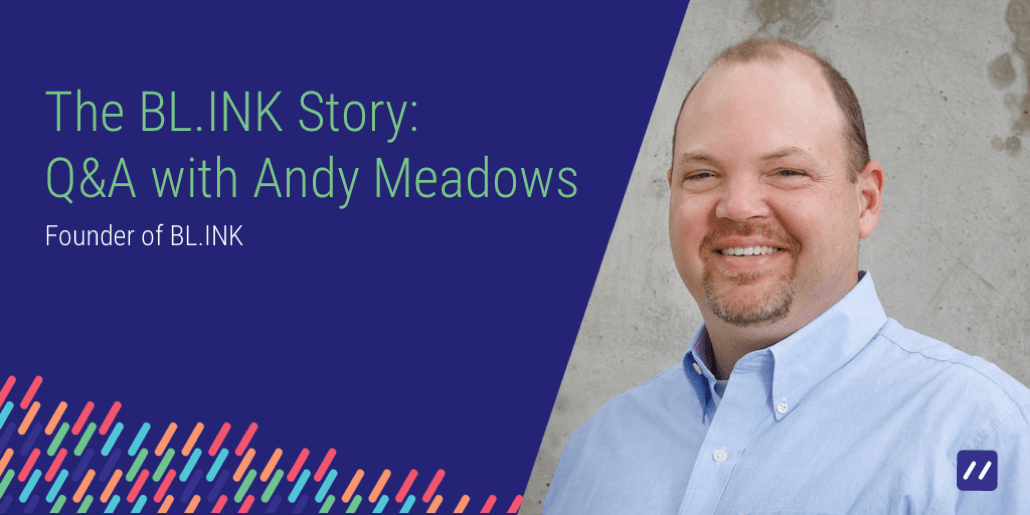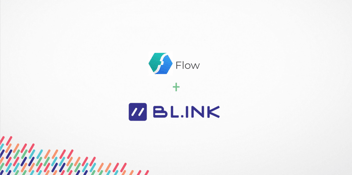
Listen to this blog
The BL.INK Story: Q&A with Andy Meadows, Founder of BL.INK
Last week, we sat down with founder Andy Meadows, to learn more about him and the “origin story” of BL.INK. This is Part One of a two-part interview:
Q: Congrats on the launch of BL.INK. This must be an exciting moment for you.
A: Thank you! It IS exciting, but keep in mind, since founding the company nearly 10 years ago, we’ve had our fair share of exciting moments, especially regarding our growing customer base.
Q: Yes, tell us more about your customers.
A: Well, they’re terrific, and we’ve been fortunate to have a productive, collaborative relationship with each of them. Our customers include some of the largest, most well-respected global brands. We are really proud to have them using our product. They include Airbnb, Patagonia, Target, United Healthcare, and many, many others.
Q: Wow: that’s quite a list!
A: Yes. And many of them have been long-term customers. We believe that really underscores the value and power of our platform.
Q: How did you get the idea to found the company?
A: Well, I’m a “serial entrepreneur” and come from a family of entrepreneurs so I grew up in an environment where any good idea had the potential to become a great business.
BudURL, now BL.INK, is actually my third start-up. In a previous company, a hosting business, we needed a way to track links via transactional emails that were not newsletter-based. We wanted an in-depth understanding of how productive our marketing efforts were. Nothing existed out there at the time – this was before short links were a “thing” – so we cooked up a solution ourselves.
Q: When did you realize this could be a new business?
A: Actually, pretty quickly. Our CTO, Mike Saenz, built a prototype in a couple of days, then ran a two-week experiment and it seemed to work pretty well. Because of my time and work in Austin, I was well integrated into the tech community, so I shared our idea, and the feedback was overwhelmingly positive. This just happened to coincide with Twitter really gaining momentum at the SXSW conference here in Austin, and suddenly social media was exploding. You know how they say, timing is everything. And it is!
Q: So then what?
A: By then I had a community of users who were lining up to pay us to build out this solution. But I refused: we wanted to focus first on building out the product, and then we’d figure out how to charge for it. That stance bought us a tremendous amount of goodwill and collaboration from our community, which meant that our development efforts were insanely productive. We ended up launching the company around the same time as Bit.ly, but from the get-go our focus was 100% different.
Q: How so?
A: We differed from the other short link players in three important ways: 1) our initial customer focus (corporate vs. consumer), 2) our philosophy of short links (strategic, valuable vs. tactical, fungible), and 3) our insistence on providing tools to analyze and quantify the links’ value-add to clients. One of our earliest tenets was that short links are the “last inch” connection between the brand and its customers. In other words, short links are a super-strategic touchpoint, so they need to be memorable, meaningful, trackable, and productive. And, in the early days, I felt that short links would matter most to large enterprises, because they understood the value of integrated marketing initiatives and were becoming increasingly savvy about the quantitative merits of digital marketing automation.
Q: Hindsight sure looks brilliant, doesn’t it?
A: Well, as I said, timing is everything. We understood the unmet need because we ourselves had that need in my hosting company. The fact that Twitter and social media were also exploding was just sheer luck. Our first big break came when Mashable did an article about short links. So after that, Mashable did a follow-up profile of a major soda brand's (and our client) use of branded short links (and our technology). Then the phones really started ringing!
Q: Today, asking the same question about product differentiation: what makes BL.INK better / different than the legacy link shorteners out there?
A: Three important differentiators:
- BL.INK was built from the ground up for enterprise, and with our customer base and track record, it’s proven to perform beautifully in enterprise environments. The competition started from the opposite direction and that (usually) means it’s hard to scale up with confidence.
- Real words. Your brand. Unlike the competition, our short links use real words based on the customer’s domain choices and/or their brand. Even at the free tier, we emphasize the importance of using real words.
- Best pricing options available. The competition is abandoning the low-end of the market and raising its prices. In contrast, BL.INK is committed to providing pricing that works for businesses of ANY size – from the enterprise down to the aspiring entrepreneur.
Q: Impressive. Fast-forward to last year: how did you encounter Donuts and what made you agree to sell the company to Donuts?
A: Like a lot of start-ups, we had bootstrapped very successfully in the early years, but decided last year to embark on fund-raising from third parties. Coincidentally, Donuts was actively looking at investing in new ways and places for domain names to be used – outside of and beyond the traditional use cases of websites and email. They became intrigued with short links and did a very thorough assessment of the market. It was a classic “meeting of the minds!”
Q: Tell us more about this “mind-meld” with Donuts.
A: When we heard about Donuts’ vision, their ecosystem, their desire to innovate and bring new products to their channel of registrars and resellers, it all made perfect sense. Donuts had a desire to grow the reasons and uses for their domain names. That desire fit perfectly with our belief that every shared link should be a branded short link: that is, an opportunity to connect with your target audience using real words that are memorable and meaningful. The synergies were really exciting. Plus, the team at Donuts are just good, solid people: they care about their customers, as we do, and they treat their employees well, just as we do. Now that I’m on the other side of that process, I can say it was a great decision. And we’re just getting started!
We’ll publish Part Two of our interview soon. Stay tuned.

